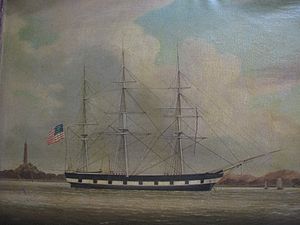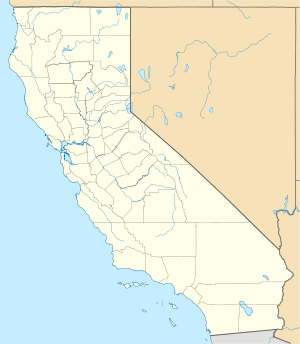 Painting of Niantic at the Whampoa anchorage near Canton
| |
| History | |
|---|---|
| Builder | Connecticut |
| In service | 1832 |
| Out of service | 1849 |
| Renamed | Niantic Hotel, 1849 |
| Fate |
|
| General characteristics | |
| Type | ship or barque |
| Tons burthen | "could probably take eight or nine hundred tons in storage"[1] |
| Length | 119 ft 6 in (36.42 m) |
| Beam | 29 ft (8.8 m) |
| Depth of hold | 19 ft 6 in (5.94 m) |
| Propulsion | Sail |
| Complement | 28 |
Niantic (Storeship) | |
| Location | NW corner of Clay and Sansome Sts., San Francisco, California |
| Coordinates | 37°47′42.3″N 122°24′8″W / 37.795083°N 122.40222°W |
| Area | 0.1 acres (0.040 ha) |
| Architect | Childs, Thomas |
| NRHP reference No. | 91000563[2] |
| CHISL No. | 88[3] |
| Added to NRHP | 16 May 1991 |
Niantic was a whaleship that brought fortune-seekers to Yerba Buena (later renamed San Francisco) during the California Gold Rush of 1849. Run aground and converted into a storeship and hotel, she was a prominent landmark in the booming city for several years. The site of Niantic beside the Transamerica Pyramid is now a California Historical Landmark. Artifacts excavated in 1978 and the ship's log from her last voyage are on display in the San Francisco Maritime Museum.
- ^
M'Collum, William, MD; Morgan, Dale L. (1960). "California as I Saw It; Pencillings by the Way of its Gold and Gold Diggers! and Incidents of Travel by Land and Water". Los Gatos, California: The Talisman Press. pp. 51–81. Retrieved 2008-11-25.
{{cite web}}: CS1 maint: multiple names: authors list (link) - ^ "National Register Information System". National Register of Historic Places. National Park Service. March 13, 2009.
- ^ "Niantic Hotel (Building)". Office of Historic Preservation, California State Parks. Retrieved 2020-05-10.
